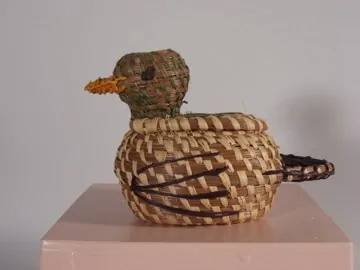February 1, 2018 – For thousands of years, indigenous people have transformed simple fibers into useful and beautiful containers, clothes, and other household materials reflecting their unique cultures. Weaving is a varied and true art form for Native people across the US and Canada, from Navajo rugs in the Southwest to woven purses in the Woodlands and Chilkat blankets in the Northwest Coast. The Mitchell Museum of the American Indian’s latest exhibit, “Native American Woven Arts,” explores the artistry and expertise of the weavers who create unique and priceless baskets, bags, rugs, blankets, and clothing. The exhibit opens to the public on Saturday, February 10.
The exhibit displays over 20 rugs and textiles and over 45 basketry objects. Visitors can learn the stories and significance behind many renowned weaving designs, such as Two Grey Hills rugs and black ask baskets. Native American designs are filled with meaning and their symbolism opens a unique door to their culture. To keep ceremonial designs sacred, many tribes required artists to alter the design so objects for sale would not contain spiritual qualities. While traditional designs shared deep cultural meaning, as Native American woven arts became more popular with tourists and collectors, many weavers further adapted traditional designs into more marketable forms.
“Weaving is not just a matter of sitting at a loom and weaving. It is not only about weaving techniques and rug designs. My weaving reflects who I am. It incorporates my beliefs, my family, and my community,” said weaver, D.Y. Begay, Navajo
The exhibit will also explore the process of creating woven pieces by hand. Many artists begin by locating, cultivating, and harvesting the plant and animal materials they use in their works. These raw materials require extensive preparation to create uniform, smooth, dyed pieces needed for each form and design. Next are the various techniques used by people across the US and Canada, such as textile finger weaving and loom weaving, as well as traditional coil, plaiting, and twined basketry weaving. Visitors can watch the film “My Father’s Tools” by Wapikoni showing basket weavers in action. Visitors can also try to do basic loom weaving and basket weaving at the family interactive stations.
This extensive traditional knowledge has been passed down for generations. Some weavers have taught themselves these techniques by researching older woven objects to reclaim these traditions. Weaving artists have also adopted pre-processed or new materials or synthetic dyes to expand their artistic expression. Indigenous artists continue these traditions in new ways, expressing and sharing with the world the vitality of their culture.
Learn about artists who helped preserve traditional techniques, such as Julia Wesaw, Potawatomi, who helped revive the arts of traditional black ash basket making in Michigan, as well as artists who are creating pieces today, such as Louise Bia Yazzie, Navajo, who weaves miniature pictorial rugs.
The exhibit opens to the public Saturday, Feb. 10, from 10a.m. to 5p.m. At 2:30, visitors can join Collections Manager Scarlett Engle on a spotlight tour of the new exhibit. The tour is included with regular museum admission.
The Mitchell Museum of the American Indian is one of only a handful of museums in the country that focuses exclusively on the art, history, and culture of American Indian and First Nation peoples throughout the United States and Canada. In 2017, the Mitchell Museum won the Illinois Association of Museums’ Superior Award for the exhibit “Contemporary Native Women Opening Doors to Change.”
For more information about The Mitchell Museum of the American Indian, visit www.mitchellmuseum.org, or call 847-475-1030. The museum is open Tuesday-Saturday, 10 a.m. to 5 p.m.; Thursday, 10 a.m. to 8 p.m.; and Sunday, noon to 4 p.m. Admission is $5 for adults, $3 for seniors, students and children, and free for Mitchell Museum members and Tribal members.








